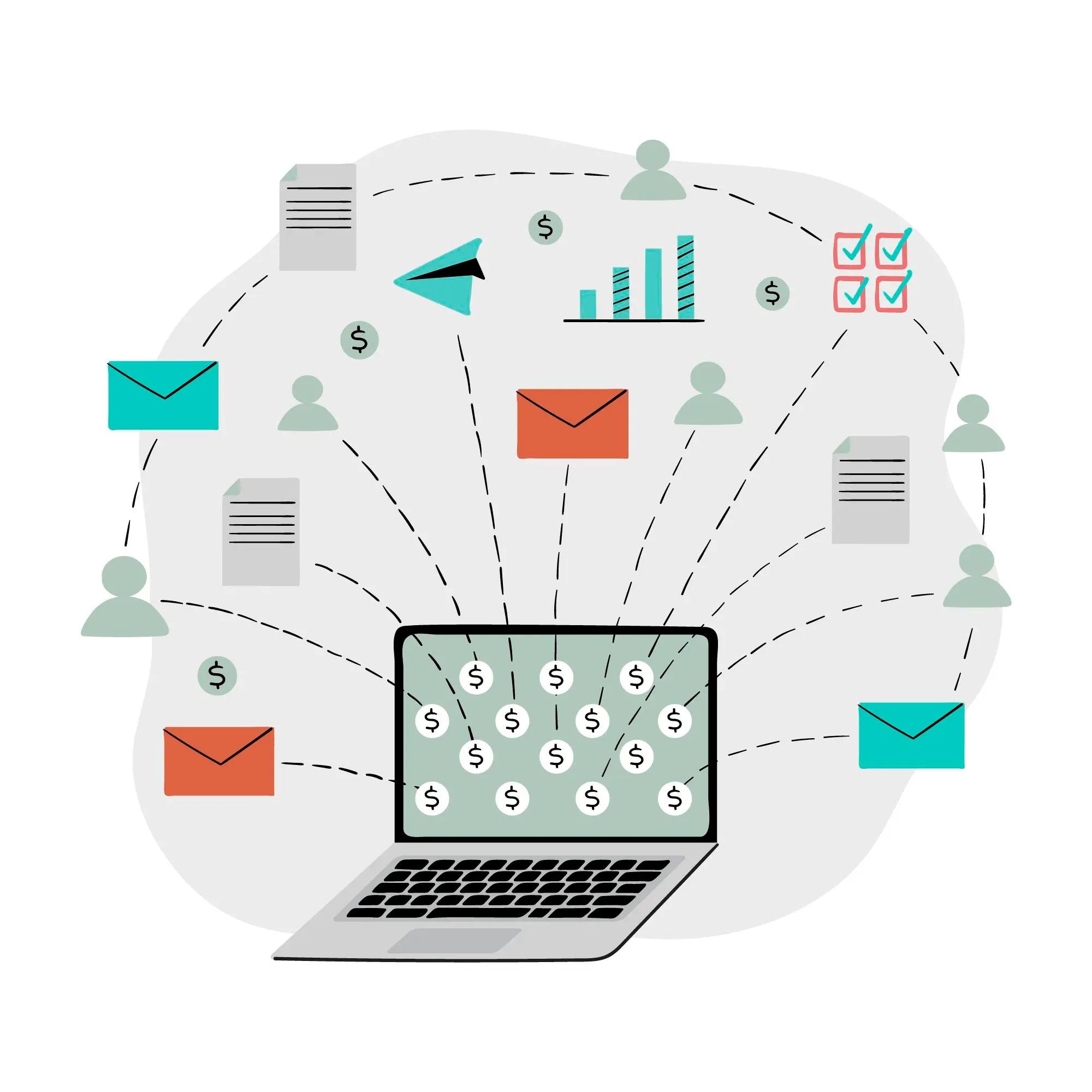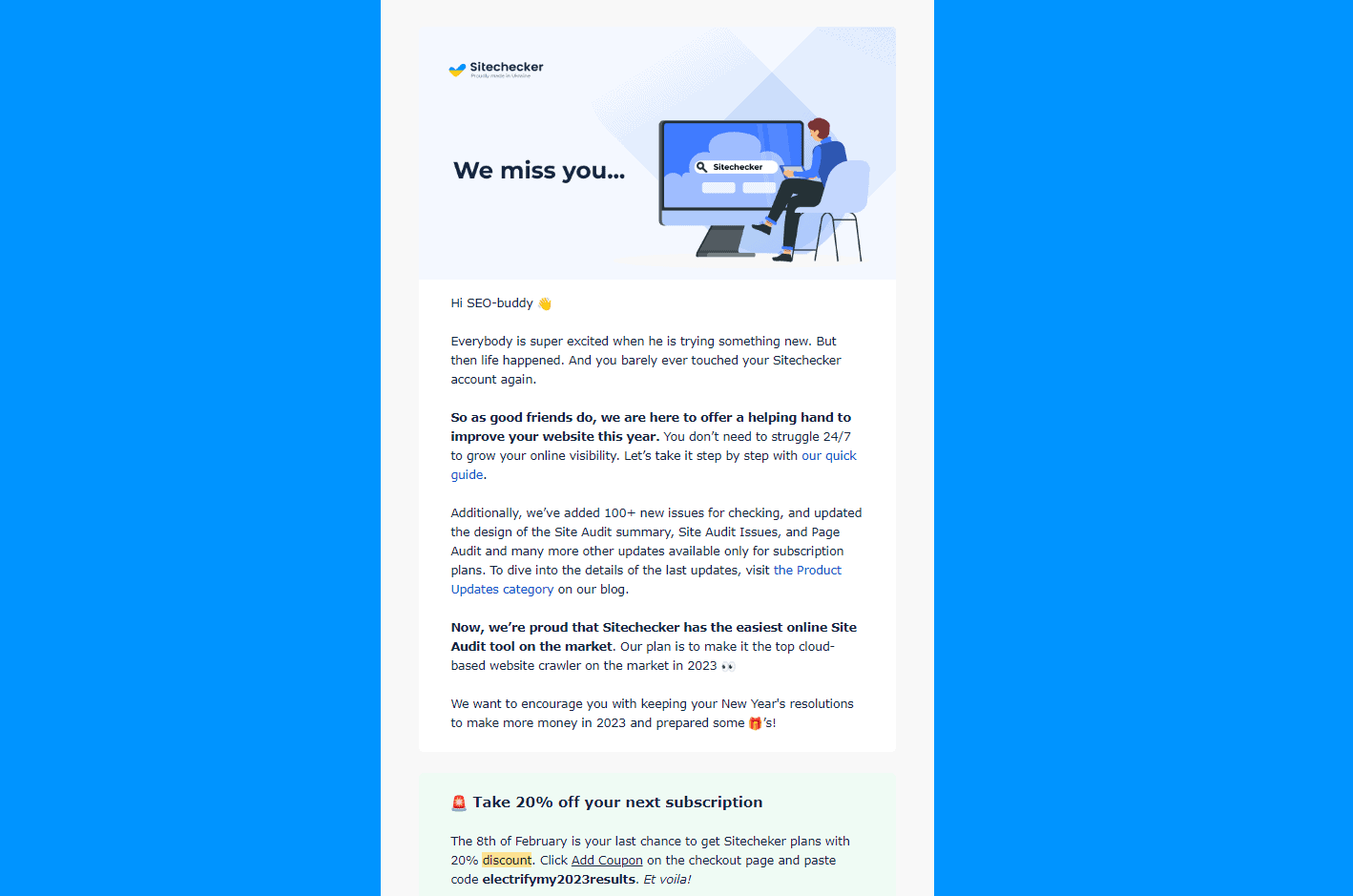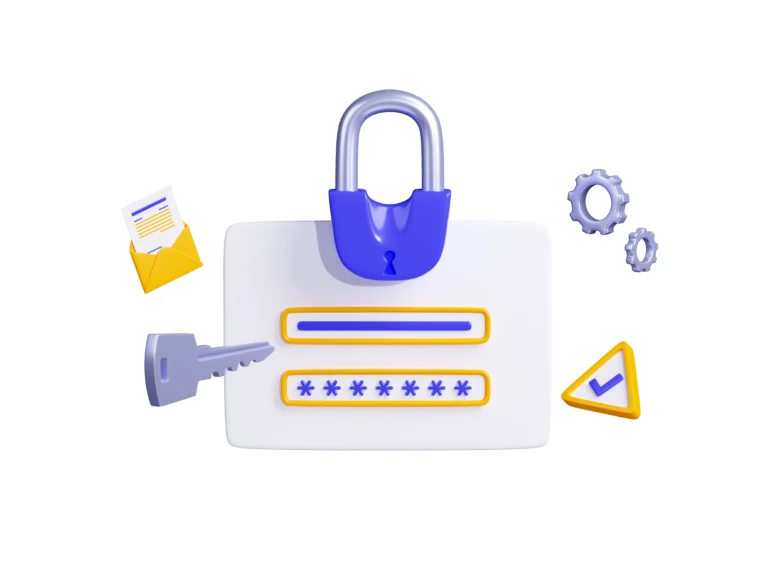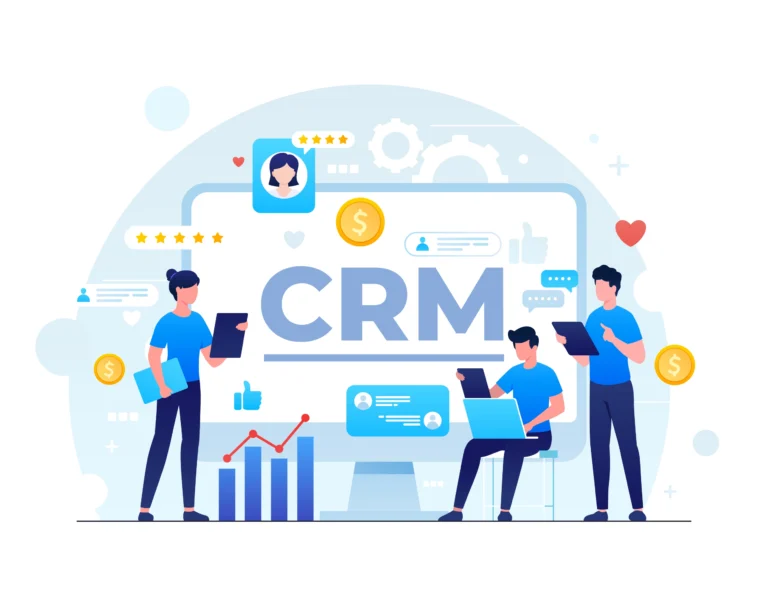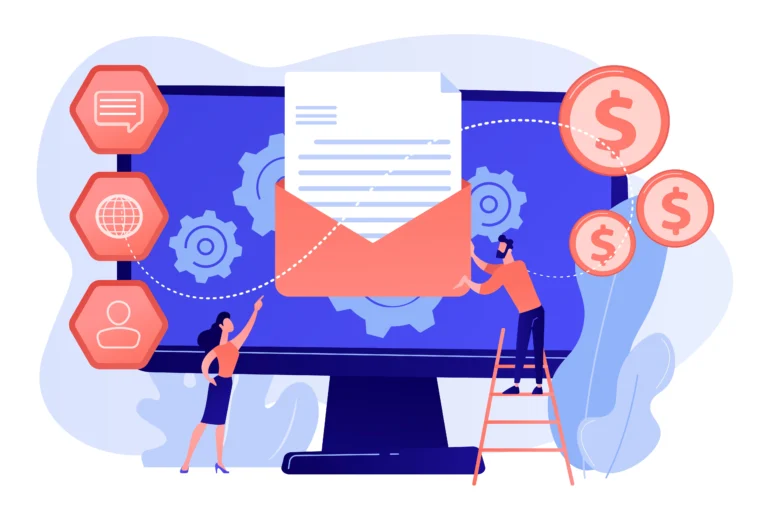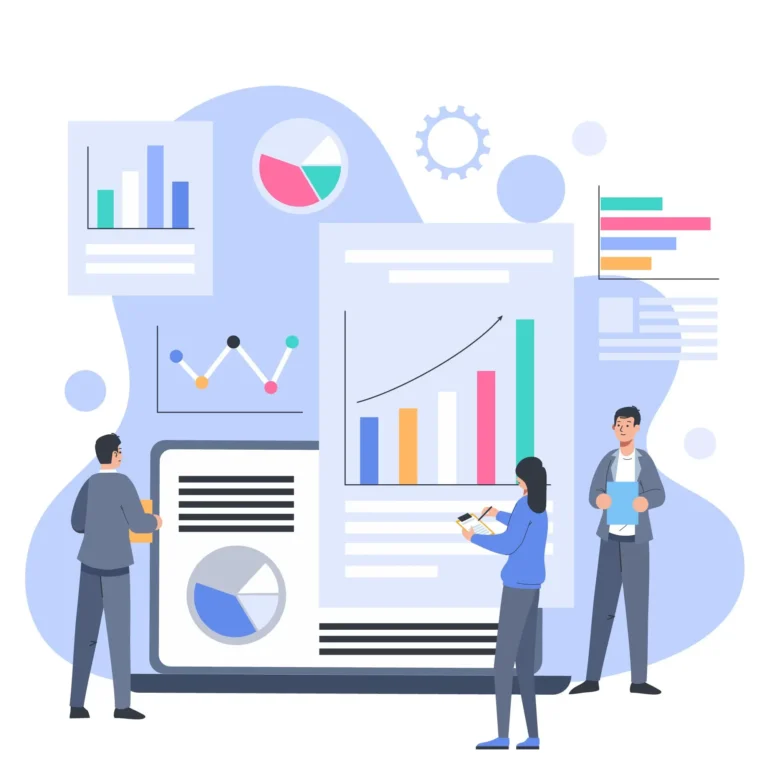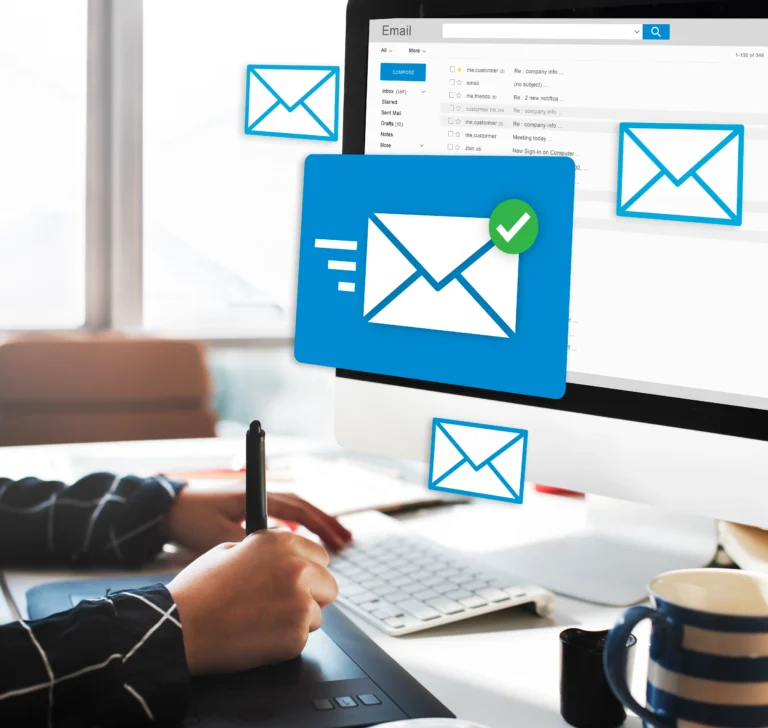37+ Powerful Email Marketing Ideas to Boost Your Success in 2023
Are you struggling to come up with new email marketing ideas in 2023? Look no further! I’ve compiled a list of 37+ email marketing ideas to help you engage your audience and drive conversions.
Whether you’re looking to increase open rates, boost click-through rates, or drive sales, our list of email marketing ideas has something for everyone. From personalized recommendations to interactive content, I’ve got you covered.
Imagine being able to use successful email marketing campaigns to draw your audience in and keep them interested in your business. With our list of email marketing ideas, you can turn that dream into a reality.
So what are you waiting for? Start implementing these email marketing ideas today and watch your engagement and conversions soar!
What Are the Best Email Marketing Ideas?
Email marketing is a tried-and-true method for communicating with clients and boosting revenues. But how can one design email marketing that stands out from the crowd amid a sea of rivalry?
The key is to approach email marketing with a unique perspective and a creative mindset. By focusing on personalization, storytelling, interactive content, and other innovative strategies, you can create email campaigns that capture attention and build relationships with your audience.
I have listed a few email marketing ideas that’ll help you for your next email marketing campaign:
-
Welcome series:
A welcome series is an automated email sequence that is sent to new subscribers to introduce them to your brand, products, or services. The series usually consists of two or more emails that are spaced out over several days or weeks.
A well-crafted welcome series can help create a positive first impression and set the tone for your ongoing relationship with the subscriber.
The series can include a welcome message that thanks the subscriber for joining your list, information about your brand, customer success stories that highlight the benefits of your products or services, and promotional offers to incentivize purchases.
-
Promotions:
Promotions are a common email marketing tactic used to drive sales and engagement. By offering discounts, coupons, or exclusive deals that are only available to email subscribers, you can incentivize subscribers to make a purchase or take a specific action.
Promotions can be time-limited, such as offering a discount code that is only valid for a certain period, or quantity-limited, such as offering a coupon that is only valid for the first 100 customers. Effective promotions can help increase sales and customer loyalty.
-
New product launch:
Announcing the launch of a new product through an email campaign is an effective way to generate excitement and build buzz around your product.
The email can include details about the product, its features and benefits, and a call-to-action to encourage subscribers to make a purchase.
To maximize the impact of your new product launch email, you can segment your email list and personalize the email content based on the subscriber’s previous purchases or browsing behavior. This can help increase engagement and sales.
-
Newsletter:
A newsletter is a regularly scheduled email sent to subscribers that shares industry news, updates, and insights. A well-designed newsletter can help establish your brand as a thought leader and keep your subscribers engaged and informed.
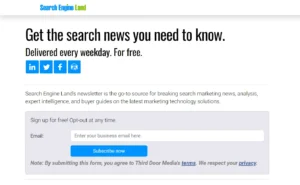
The above example is from the search engine land Website, which provides search marketing news, analysis, and free guides on the latest marketing technology solutions.
Newsletters can include a mix of content, such as blog posts, articles, infographics, and promotional offers. By providing valuable content that your subscribers find useful or interesting, you can help build trust and credibility with your audience.
-
Survey or feedback request:
Asking subscribers for their opinions or feedback through a survey or feedback request can help you better understand your customers’ needs and preferences. This information can be used to improve your products, services, or email marketing campaigns.
To increase the response rate of your survey or feedback request email, you can offer an incentive, such as a discount code or entry into a prize draw, for completing the survey.
You can also personalize the survey questions based on the subscriber’s previous purchases or browsing behavior.
-
Abandoned cart:
An abandoned cart email is sent to customers who added products to their cart but did not complete their purchase. The email can include a reminder of the items in their cart, a call-to-action to complete their purchase, and a promotional offer to incentivize them to do so.
By targeting customers who have already shown an interest in your products, abandoned cart emails can be highly effective at driving sales and increasing revenue.
-
Re-engagement campaign:
A re-engagement campaign is sent to inactive subscribers to encourage them to re-engage with your brand. The email can include a special offer, a survey to gather feedback or a reminder of the benefits of being a subscriber.
Re-engagement campaigns can help improve email deliverability and engagement rates by removing inactive subscribers from your list and targeting those who are most likely to engage with your brand.
-
Testimonial request:
Asking satisfied customers to provide testimonials and sharing them with your email list can help build trust and credibility with potential customers.
Testimonials can be used to highlight the benefits of your products or services and can be incorporated into your email marketing campaigns or displayed on your website.
To increase the likelihood of receiving testimonials, you can offer an incentive, such as a discount or free product, for providing feedback.
-
Seasonal or holiday promotions:
Offering seasonal or holiday-specific promotions or sales to your email list is a great way to drive sales during peak shopping periods.
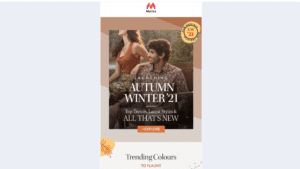
This is a seasonal promotion by a Fashion & Lifestyle website
These types of promotions can include discounts, special offers, or limited-time deals that are specific to a particular holiday or season. By targeting subscribers with these types of promotions, you can increase engagement and encourage them to make a purchase.
-
Event invitation:
Event invitations can help build brand awareness and engagement. By inviting subscribers to attend a virtual or in-person event related to your brand, you can provide them with a unique experience and connect with them in a more personal way.
These event invitations can help strengthen their relationship with your brand and increase the likelihood of future purchases.
-
Upsell or cross-sell:
Upsell or cross-sell recommendations can help increase sales and customer loyalty. By recommending related products or services to customers who have made a purchase in the past, you can encourage them to consider additional items that may be of interest to them.
This can also help build trust and credibility with customers by showing that you have their best interests in mind.
-
Personalized recommendations:
Personalized recommendations based on customer behavior can help increase engagement and sales. By using data and analytics to personalize product recommendations, you can show customers that you understand their preferences and needs.
This can help create a more personalized experience for them and increase the likelihood of them making a purchase.
-
Referral program:
Referral programs can help increase brand awareness and customer acquisition. By encouraging customers to refer their friends and family to your brand, you can leverage their existing relationships to reach new potential customers.
It can also help build trust and credibility, as referrals from satisfied customers are often seen as more trustworthy than other forms of advertising.
-
Educational content:
Providing valuable educational content related to your industry or product can help position your brand as a thought leader and increase engagement with your email list.
By sharing insights and knowledge with subscribers, you can demonstrate your expertise and provide them with valuable information that can help them make more informed purchasing decisions.
-
Social proof:
Sharing social proof, such as customer reviews or ratings, can help build trust and credibility with potential customers. By showcasing the experiences of satisfied customers, you can provide social proof that your products or services are high quality and trustworthy.
It can help overcome any doubts or concerns that potential customers may have and increase the likelihood of them making a purchase.
-
User-generated content:
Sharing user-generated content, such as customer photos or videos, can help showcase your product in action and increase engagement with your email list.
By sharing content created by customers, you can provide a more authentic and relatable perspective on your products or services. This can help build trust and credibility with potential customers and increase their likelihood of making a purchase.
-
Milestone celebration:
A milestone celebration email is a great way to show your email subscribers that you value their support and to celebrate your achievements with them.
You can use this opportunity to share your success story, thank your customers for their loyalty, and offer exclusive promotions or discounts to express your gratitude. This email can also help to increase brand loyalty and foster a sense of community among your subscribers.
-
Thank-you email:
Sending a personalized thank-you email to customers after a purchase or subscription can help build brand loyalty and increase customer satisfaction.
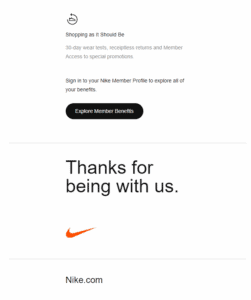
Above is a thank-you email from nike
A personalized thank-you email is a simple yet powerful way to show your appreciation to your customers. You can customize the email to include the customer’s name, their recent purchase or subscription, and a sincere thank-you message.
These types of emails can also include a call-to-action to encourage customers to share their experience on social media or leave a review.
-
Product recommendations:
Sending product recommendations based on past purchases or browsing behavior can help to increase sales and engagement with your email list.
By analyzing customer data and behavior, you can offer personalized product recommendations that are more likely to appeal to each subscriber. This can increase the chances of them making a purchase and help to build brand loyalty.
-
Exclusive content:
Providing exclusive content or sneak peeks to your email subscribers can help to make them feel valued and increase engagement with your brand.
You can offer early access to new products, behind-the-scenes content, or exclusive promotions. This type of email can also include a call-to-action to encourage subscribers to share the content with their friends or followers on social media.
-
Social media integration:
Integrating your social media accounts into your email marketing campaigns can help to increase engagement and followers on your social media platforms.
You can include social media icons in your emails to encourage subscribers to follow your brand on different platforms. You can also create social media-specific promotions or campaigns to encourage subscribers to engage with your brand on social media.
-
Segmented campaigns:
Sending targeted and personalized email campaigns based on subscriber demographics, behavior, or purchase history can help increase engagement and sales.
By segmenting your email list and tailoring your messaging to specific groups, you can create more relevant and personalized email campaigns that resonate with your subscribers. This can lead to higher open rates, click-through rates, and conversion rates.
-
Limited-time offers:
A limited-time offer email creates a sense of urgency and encourages subscribers to take action quickly. You can use this email to promote a special sale or discount that is only available for a short period of time.
Limited offer Email from sitechecker
This type of email can also be personalized by offering different promotions to different segments of your email list based on their purchase history or preferences.
-
Customer stories:
Sharing customer success stories or case studies can help build trust and credibility with potential customers and increase engagement with your email list.
By showcasing how your product or service has helped real customers, you can demonstrate the value of your brand and increase the chances of new subscribers becoming customers. This type of email can also include a call-to-action to encourage subscribers to share their own success stories or leave a review.
-
Interactive content:
Interactive content such as polls, quizzes, or surveys can make email campaigns more engaging by encouraging subscribers to interact with the brand. It can also help gather valuable insights about customer preferences and behaviors.
Polls can be used to gather customer feedback on products, while quizzes can help educate customers about the brand and its offerings.
Surveys can be used to gather more in-depth information about customer demographics and preferences. These interactive elements can be used strategically in email campaigns to increase engagement and ultimately drive sales.
-
Brand updates:
Keeping subscribers informed about brand updates can help build brand loyalty and keep customers engaged with the brand. For example, sharing information about new hires can help showcase the company culture and introduce customers to the team behind the brand.
Sharing information about new office locations or partnerships can help customers feel more connected to the brand and stay up-to-date with the latest news.
By keeping subscribers informed about brand updates, brands can foster a sense of community and build a deeper connection with their audience.
-
Referral discounts:
Offering referral discounts is a powerful way to incentivize customers to refer their friends to the brand. Referral programs can be designed to offer discounts or rewards to customers who refer new businesses, which can help increase customer acquisition and loyalty.
Personalized discount codes can also be sent to customers after they refer a friend to the brand. This can help increase engagement and ultimately drive sales, as customers are more likely to make a purchase when they have a discount code.
-
Birthday or anniversary emails:
Sending personalized birthday or anniversary emails to subscribers can help build a deeper connection with the audience and increase engagement.
This gesture shows customers that the brand cares about them and values their relationship. Including a special offer or discount as a birthday or anniversary gift can incentivize customers to make a purchase and increase sales.
By sending these personalized emails, brands can build stronger relationships with their audience and foster loyalty.
-
Loyalty program updates:
Keeping subscribers informed about updates to the loyalty program can help increase customer loyalty and engagement. By introducing new rewards or perks, brands can incentivize customers to continue doing business with them.
These updates can also help keep customers engaged with the brand and encourage them to make more purchases. By communicating loyalty program updates through email, brands can keep their audience informed and foster a sense of exclusivity among loyal customers.
-
Product tutorials or how-to guides:
Product tutorials or how-to guides can be valuable educational resources for customers. These types of emails can help customers learn more about the brand and its offerings, which can increase engagement and drive sales.
By providing tutorials or guides on how to use the products or services, brands can help customers get the most out of their purchases. This can lead to increased customer satisfaction and loyalty.
-
Expert tips and advice:
Sharing expert tips and advice can help position the brand as a thought leader in the industry.
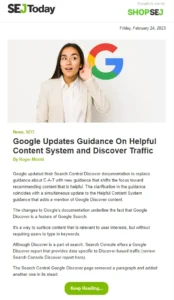
The above image is from Search Engine Journal
By providing valuable insights and information related to the brand or industry, brands can increase engagement with their email list and build credibility with their audience. This can help establish trust with potential customers and lead to increased sales.
-
Event follow-up:
Following up with attendees of an event, whether virtual or in-person, can help build a deeper connection with the audience and increase engagement.
By providing a recap of the event and any follow-up actions, brands can show customers that they value their participation and feedback. This can also help keep the brand top-of-mind for attendees and increase the likelihood of future purchases.
By following up with attendees through email, brands can continue to build relationships with their audience and foster loyalty.
-
Influencer collaborations:
Influencer collaborations involve partnering with an influencer and including them in your email marketing campaigns, such as featuring their content or promoting their products.
This approach can help increase brand awareness and reach a wider audience through the influencer’s following. When executed well, it can also create trust and credibility with your target audience.
However, it’s important to choose an influencer whose values and content align with your brand and audience to ensure authenticity and maximize engagement.
-
Customer service follow-up:
Following up with customers after a customer service interaction can help improve customer satisfaction and increase engagement. A follow-up email can be used to thank the customer for their business and offer any additional support or resources.
This can help build a personal connection with the customer and make them feel valued. Additionally, addressing any concerns or issues the customer had in a timely and effective manner can help foster loyalty and increase the likelihood of repeat business.
-
Industry news and updates:
Sharing relevant industry news and updates with your email list can help position your brand as a knowledgeable source in your industry and increase engagement. This can include industry trends, insights, and events that are of interest to your target audience.
By providing valuable information to your subscribers, you can establish your brand as a thought leader and increase trust and credibility with your audience.
-
Seasonal or holiday greetings:
Sending seasonal or holiday greetings to your email list can help build a personal connection with your audience and increase engagement.
These emails can be personalized to reflect the recipient’s preferences and interests, and can include festive messages or offers. By acknowledging special occasions, such as birthdays or holidays, you can make your audience feel valued and appreciated.
-
Free resources or downloads:
Offering free resources or downloads through email, such as ebooks, whitepapers, or templates, can help increase engagement and provide value to your audience. These resources should be relevant to your target audience’s interests and needs and can be used to educate and inform them on relevant topics.
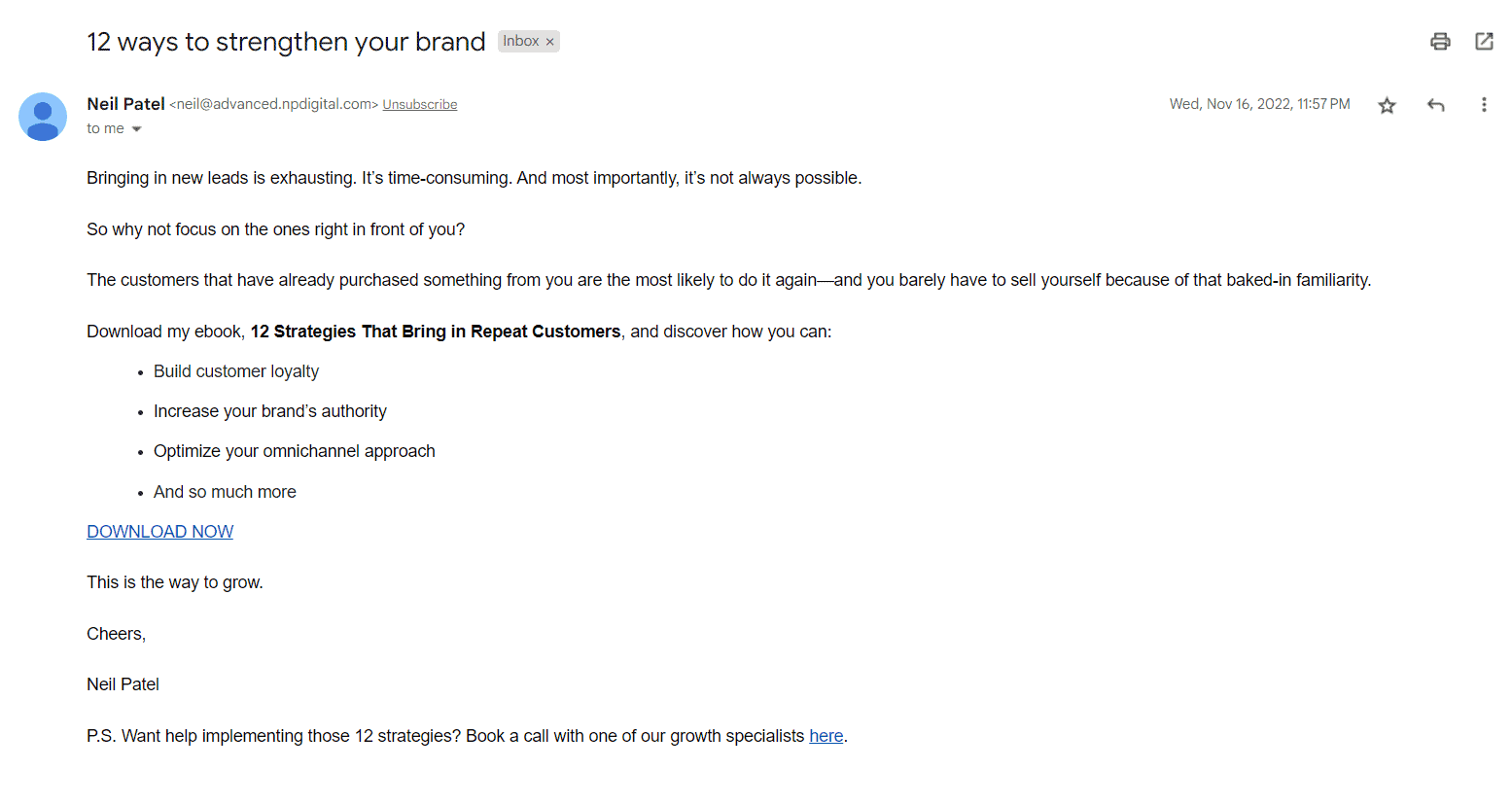
This Email provides a free resource and it is from NeilPatel
By providing valuable content for free, you can establish trust and credibility with your audience and encourage them to engage further with your brand.
What Is Email Marketing?
Email marketing is an incredibly potent and efficacious approach for businesses to captivate and entangle their intended target audience. The capacity to personalize content and specifically aim at particular segments of an email list enables businesses to fabricate remarkably pertinent and compelling campaigns that generate notable outcomes.
Among the various perks of email marketing, one of the most prominent is its cost-effectiveness. Compared to other forms of advertising, like archaic print or TV ads, email marketing is exceptionally inexpensive. Moreover, businesses can seamlessly track and scrutinize pivotal metrics such as open rates, click-through rates, and conversion rates to refine their campaigns and optimize ROI.
To thrive in email marketing, businesses must conceive of and fabricate captivating and invaluable content that deeply resonates with their subscribers. This can encompass promotional offers, educational content, and entertaining newsletters. It is also paramount to optimize emails for mobile devices, given that an ever-increasing proportion of people are scrutinizing their emails on smartphones and tablets.
Overall, email marketing is an enormously robust tool that can assist businesses in nurturing relationships with their audience, generating leads, and driving sales. By implementing the right strategies and tactics, businesses can devise highly effective campaigns that burst through the noise of a saturated inbox and triumphantly accomplish their marketing objectives.
How Can Email Marketing Benefit You?
When it comes to connecting with customers and boosting revenue, email marketing has the power to fundamentally shift the game. This is why:
Firstly, it’s a cost-effective way to reach your target audience. Forget about expensive print or TV ads, email marketing is where it’s at. To optimize your campaigns and maximize your investment, track important data like open rates, click-through rates, and conversion rates
Secondly, email marketing helps you build relationships with your subscribers over time. By providing valuable and relevant content, you can earn your audience’s trust and credibility. That’s huge because it can lead to loyal customers who keep coming back for more.
Lastly, email marketing is great for generating leads and conversions. Use emails to promote products, services, or special offers, and watch the sales roll in. Plus, you can even upsell or cross-sell to existing customers, increasing their lifetime value to your business.
Frequently Asked Questions:
What are the 4 types of email marketing?
There are four main types of email marketing campaigns:
- Newsletter: A regular communication sent to subscribers that typically includes updates, news, and promotions related to your business or industry.
- Promotional: An email designed to promote a specific product, service, or sale. These emails often include a call-to-action encouraging recipients to make a purchase.
- Behavioral: An email triggered by a specific action taken by a subscriber, such as abandoning a shopping cart or viewing a particular product on your website.
- Lifecycle: An email campaign designed to engage with subscribers at various stages of the customer lifecycle, from welcome emails for new subscribers to re-engagement emails for inactive ones. These emails are often personalized based on the subscriber’s interests and behavior.
By utilizing a combination of these different types of email campaigns, businesses can effectively engage with their audience and drive conversions.
How do email marketing campaigns work?
Email marketing campaigns typically involve sending promotional or informational emails to a list of subscribers. By subscribing to a newsletter or making a purchase, these subscribers have given their consent to receive emails from the company or organisation.
Businesses often employ an email service provider (ESP) to manage their subscriber list, create, and send emails for email campaigns. Depending on the sort of campaign, the email’s content may change, but it should always be interesting and pertinent to the subscriber’s requirements and interests.
Once the email has been delivered, companies may monitor crucial stats like open rates, click-through rates, and conversions to assess the campaign’s effectiveness. With this data, businesses can refine their email marketing strategy over time to improve engagement and drive more conversions.
In general, email marketing campaigns are a successful strategy for businesses to engage with their clients, forge long-lasting bonds, and boost sales. By utilizing the right strategy and tools, businesses can create compelling email campaigns that resonate with their subscribers and drive results.
How should I email to attract customers?
It’s crucial to produce interesting, personalized content that connects with your audience if you want to draw clients to your business through email marketing. Here are some tips for crafting effective marketing emails:
- Segment your list: Group your subscribers based on their interests, behavior, or other demographics to create more targeted and relevant emails.
- Personalize your content: Use the subscriber’s name and tailor the content to their interests and needs. This can include personalized product recommendations, exclusive offers, or relevant industry news.
- Use attention-grabbing subject lines: Make sure your subject line is concise and attention-grabbing to entice subscribers to open the email.
- Add a strong call to action: Use a call-to-action (CTA) that is obvious and prominent in your email, such as “Buy Now” or “Learn More,” to entice readers to take action.
- Optimize for mobile: Make sure your email is optimized for mobile devices, as more and more subscribers are opening emails on their smartphones.
- Test and optimize: Experiment with different elements of your email campaigns, such as subject lines, CTAs, and content, and use data to optimize and refine your strategy over time.
By following these best practices, businesses can create effective email campaigns that attract and engage customers, ultimately driving conversions and revenue.
Wrapping Up:
These are just a few examples of the many email marketing ideas you can use to engage and convert your email subscribers.
Each of these email marketing ideas can be tailored to fit your brand and audience and should be tested to see what works best.
Experiment with different tactics and strategies to find what works best for your brand and audience. The key is to provide value, build relationships, and keep your audience engaged over time.

